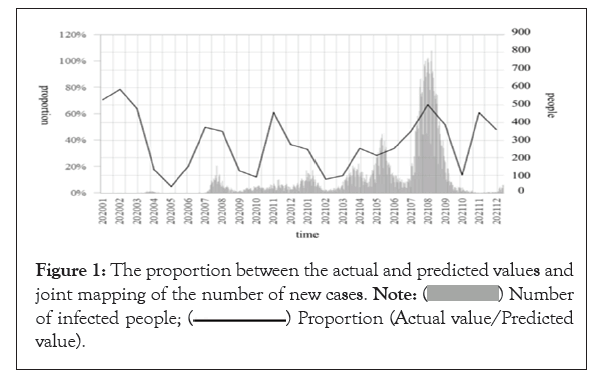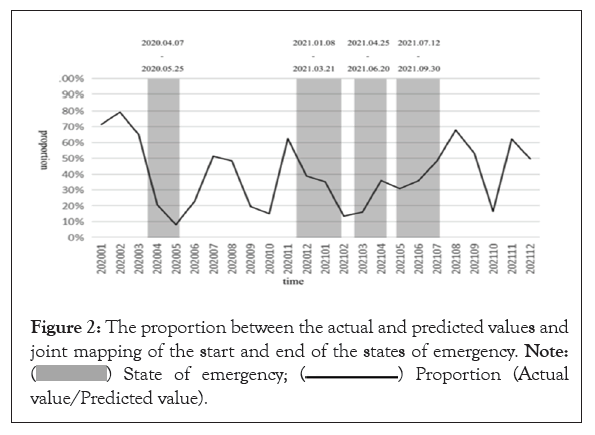Journal of Tourism & Hospitality
Open Access
ISSN: 2167-0269
ISSN: 2167-0269
Research Article - (2023)Volume 12, Issue 3
This study utilized data from Trip advisor to develop an ARIMA model and analyze changes in visitors' inclination to utilize urban parks in the Okinawa region during the COVID-19 pandemic. The findings indicated that urban parks effectively managed the risks associated with the pandemic and prevented a complete stagnation of local tourism. The study observed a positive correlation between visitors' willingness and the number of new COVID-19 cases, with swift responses to surges in cases. However, the study also highlighted that while initial state of emergency declarations could decrease visitor willingness, they were not sustainable. After the lifting of restrictions, there was a rapid increase in the number of visitors and new cases, potentially hindering pandemic control efforts and exacerbating the situation.
Anti-pandemic policies; Urban parks; Tourist behavior; COVID-19
Urban parks provide good ecological and recreational environments for users and positively influence their physical and mental health. During crises, urban parks’ influence on people may change [1]. For example, in 2020, governments worldwide implemented policies (e.g., public mobility restrictions) to reduce the spread of COVID-19, which impacted people’s lives in multiple ways. These policies led to less frequent public space visits and shifts in preferences regarding places to visit [2].
The Okinawa region is a famous tourist destination in Japan. Since the region has various cities, tourists and local residents spend most of their time travelling within urban areas, making urban parks, including human-made green areas and traditional gardens, the most popular places for people to visit. However, Okinawa’s tourism industry was severely impacted by COVID-19, with tourism revenues plummeting by 64% in 2020 compared with the previous year. During this period, various tourists cancelled their planned trips to Okinawa and changed their public space use because of safety concerns potentially greatly affecting people’s willingness to use urban parks [3].
Most countries, including Japan, are planning to fully lift their strict health policies from 2023. Since the lifting of these policies may lead to various opportunities for recovery across numerous sectors, understanding the changes that occurred during the pandemic is necessary [4]. Accordingly, various researchers conducted studies on urban parks during the pandemic. Specifically, the beneficial social effects of green infrastructure in urban parks during the strict Spanish embargo were explored [5]. Further, researchers used correlation analysis to assess urban park use in Beijing during the COVID-19 pandemic [6]. However, fewer researchers examined the overall temporal context of the pandemic, and visitors’ willingness to use urban parks under normal conditions.
We used an ARIMA model to assess the impact on visitor utilization during the pandemic. The results can provide more comprehensive judgments in the post-pandemic era about trends in visitor activity behavior during public health emergencies.
This study used trip advisor as the exclusive data source to address the issues of duplicated posts by the same user across different platforms and statistical bias caused by varying numbers of users on each platform. And the official statistics did not comprehensively cover most free attractions. Using user-generated conte//nt data from Trip Advisor was able to cover almost sites and provide a broader coverage of the study area with advantages [7]. The first COVID-19 case in Okinawa was detected on January 2020 and Japanese government rescinded the state of emergency in the end of 2021. We therefore considered the period from January 2020 to December 2021 as the strict pandemic prevention and control period in Okinawa.
The ARIMA model converts a time series into a stationary time series and obtains a forecasting model by fitting the autoregressive and moving average of the series [8]. Based on monthly posts number data before the outbreak, We build an ARIMA (0,1,1) × (1,0,1) model of urban parks use and compared the proportion between the actual and predicted value of postings during the pandemic. This allowed for assessing the extent of the impact of the pandemic on urban park use based on visitor utilization trends under normal conditions.
The predicted values showed that the relatively high posting predictions during the New Year. However, from June to September, traditionally the peak of the summer tourist season in the region [9,10]. The number of visitors using urban parks is relatively low, possibly because visitors are more likely to go to the beach or participate in outdoor activities away from the city (Table 1).
| Time | Actual value | Predicted value | Proportion |
|---|---|---|---|
| Jan-20 | 45 | 63.01085 | 71.42% |
| Feb-20 | 39 | 49.29531 | 79.12% |
| Mar-20 | 36 | 55.36756 | 65.02% |
| Apr-20 | 12 | 58.42946 | 20.54% |
| May-20 | 4 | 49.96236 | 8.01% |
| Jun-20 | 9 | 39.53134 | 22.77% |
| Jul-20 | 22 | 42.88677 | 51.30% |
| Aug-20 | 21 | 43.44965 | 48.33% |
| Sep-20 | 8 | 41.03415 | 19.50% |
| Oct-20 | 7 | 46.88127 | 14.93% |
| Nov-20 | 24 | 38.44724 | 62.42% |
| Dec-20 | 18 | 46.40153 | 38.79% |
| Jan-21 | 20 | 56.9296 | 35.13% |
| Feb-21 | 6 | 44.90611 | 13.36% |
| Mar-21 | 8 | 50.22924 | 15.93% |
| Apr-21 | 19 | 52.91341 | 35.91% |
| May-21 | 14 | 45.49087 | 30.78% |
| Jun-21 | 13 | 36.34669 | 35.77% |
| Jul-21 | 19 | 39.28817 | 48.36% |
| Aug-21 | 27 | 39.78161 | 67.87% |
| Sep-21 | 20 | 37.6641 | 53.10% |
| Oct-21 | 7 | 42.78988 | 16.36% |
| Nov-21 | 22 | 35.39633 | 62.15% |
| Dec-21 | 21 | 42.36932 | 49.56% |
Table 1: The actual and predicted values of postings during the pandemic.
We observed that climate was not a major factor influencing the propensity of visitors to use. Figure 1 shows the plot of the posting proportion and the number of new infection cases in Okinawa during the same period. Results showed that the decrease in relative postings was the most pronounced in April 2020, when the first small new case peak occurred. After this first peak, the relative postings gradually increased, reaching 51.30% of the predicted value during the second new case peak. After new case growth rates leveled off, the relative postings first dropped significantly to 14.93%, and then began to increase, reaching a maximum of 62.42% of the predicted value. In August 2021, there was a new case peak, which was accompanied the high postings. After October 2021, there was a significant decrease in new cases and a rapid reduction in the relative postings.

Figure 1: The proportion between the actual and predicted values and joint mapping of the number of new cases.  of infected people;
of infected people; Proportion (Actual value/Predicted value).
Proportion (Actual value/Predicted value).
We observed that the relative postings positively correlated with the number of new cases, and that the lag effect of the consequent change was small. This phenomenon may be caused by the severity of the pandemic and tourists still wanting to visit green spaces after the temporary closure of popular sites (e.g., beaches), leading them to seek urban parks as sightseeing alternatives. Urban parks provide safe places; can meet public demands for outdoor activities thus avoiding complete tourism stagnation. The major advantages of urban parks over other tourism resources in the Okinawa region are that their use is less affected by climatic factors, they have higher flexibility and adaptability, and they can provide similar tourism experiences year-round to meet different tourism needs because their use can be easily planned and adapted [11]. Nonetheless, an increase in the number of people using urban parks amid public health crises can exacerbate cross-infection risks, potentially contributing to an increase in new cases.
During the COVID-19 pandemic, the Japanese government declared four times of the state of emergency; they were accompanied by social distancing measures, such as the closing of commercial facilities and cancelling of major events. Figure 2 shows the postings proportion and the start and end of the state of emergency. Results showed a general trend of gradual recovery for the relative postings between the first and second states of emergency, albeit it fluctuated rapidly with the increase and decrease in new cases. Hence, the state of emergency in the early stages of the outbreak may have made visitors feel safe because it indicated that the relevant authorities were taking steps to protect peoples’ health and safety and that recovery would be relatively less difficult. The time interval between the second and fourth states of emergency was very short. Overall, the relative postings showed a long period of low values, while its rate of recovery after the decline was slow. This may be because the government repeatedly declared and retracted the state of emergency in a short period and led to a decrease in tourist enthusiasm, and uncertainty about when travelling would be safe, and made tourists more hesitant to resume urban park use. Although these states of emergency limited people’s contact to some level, their rescindment was followed by a rapid increase in the number of relative posts and new cases, which may be related to people’s pent-up desire to travel during the period when social distancing measures were enforced. Thus, these short-term mandatory policies seemingly did not significantly/effectively control the spread of the virus and may have had counterproductive effects (Figures 1 and 2).

Figure 2: The proportion between the actual and predicted values and joint mapping of the start and end of the states of emergency. Note:  State of emergency;
State of emergency; Proportion (Actual value/Predicted value).
Proportion (Actual value/Predicted value).
The findings show that, first, urban parks in the region coped well with the risks of the emergency and helped avoid complete local tourism stagnation. Second, during the same period, visitors’ willingness to use urban parks was positively correlated with new cases, and the change in their willingness to use urban parks was extremely rapid. Third, the state of emergency declarations reduced tourists’ willingness to use urban parks and helped mitigate the rapid spread of the virus. However, because these measures are unsustainable, their rescindment may often lead to a retaliatory increase in urban park use and a subsequent increase in new cases. This may hinder the effective containment of the virus and even risk increasing the severity of the pandemic.
[Crossref] [Google Scholar] [PubMed]
[Crossref] [Google Scholar] [PubMed]
[Crossref] [Google Scholar] [PubMed]
[Crossref] [Google Scholar] [PubMed]
Citation: Yang R, Takeda S, Zhang J, Liu S (2023) COVID-19 and Urban Parks use in Okinawa: ARIMA Assessment. J Tourism Hospit.12:524.
Received: 08-Jun-2023, Manuscript No. JTH-23-24946; Editor assigned: 12-Jun-2023, Pre QC No. JTH-23-24946 (PQ); Reviewed: 26-Jun-2023, QC No. JTH-23-24946; Revised: 03-Jul-2023, Manuscript No. JTH-23-24946 (R); Published: 10-Jul-2023 , DOI: 10.35248/2167-0269.23.12.524
Copyright: © 2023 Yang R. This is an open-access article distributed under the terms of the Creative Commons Attribution License, which permits unrestricted use, distribution, and reproduction in any medium, provided the original author and source are credited.